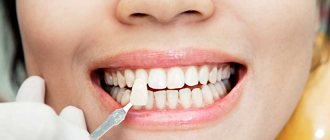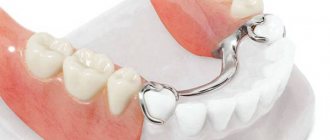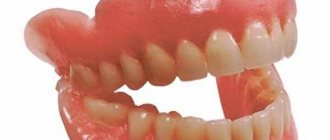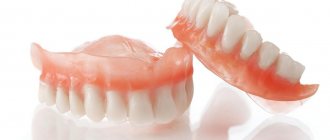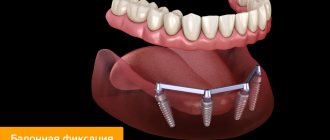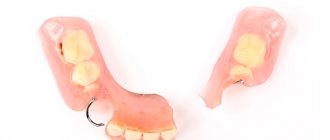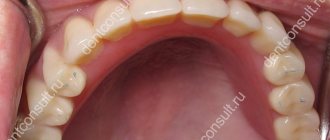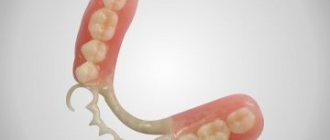Removable dentures are installed to correct dental defects when it is impossible to carry out implantation or install a conventional bridge. The dental structure is fixed to healthy, adjacent teeth. For this purpose, clasps, elastic straps, and special locks are used. In case of total edentia, the defect can be corrected with a complete removable denture.
When are removable dentures installed?
Indications for installation:
- pathological abrasion of enamel;
- multiple defects in a row;
- absence of 1 or more teeth in a row.
Contraindications:
- acute diseases of the oral cavity;
- drug use:
- destruction of bone tissue;
- severe psycho-emotional disorders;
- presence of deep bite;
- bruxism;
- intolerance to materials (allergy);
- lack of support.
Temporary contraindications include: diseases of the oral cavity, pregnancy, lactation, acute diseases of the whole body.
New generation prosthetics without palate
Over time, new forms of products and their varieties appear. One of the most modern options is the new generation Sandwich design. This is a palateless product suitable for partial dentures. The base is made of acrylic material of increased rigidity; telescopic crowns made of soft material are placed on the existing teeth. They are the ones who provide the fastening.
Read Clasp dental prosthetics: varieties by type of fastening, prices and care
Prices for new generation prostheses
A product without a sky will cost from 40 thousand rubles. When using special sets or increasing the number of supporting teeth, the price will be higher.
Who is suitable for the new generation of prostheses?
But Sandwich is not the only skyless design option. Clasp products also lack a massive base that covers the palatal part and sublingual space. Such dentures have better fixation and chewing efficiency.
Constructions of the new generation are placed only if there are own chewing elements, and telescopic crowns significantly increase their size. The chewing pressure in Sandwich dentures goes entirely to the small base and gum tissue. There is virtually no fastening at the front.
Types of removable dentures
The following types are distinguished:
- Plate (plastic). The design is popular due to its affordability. Designed to restore lost tooth fragments in a row. The product rests its base on the gum surface and is held in the mouth by clasps. Metal hooks are attached to adjacent supporting teeth.
- Immediate or “butterflies”. They can be permanent or temporary. They are often installed before implantation, after tooth extraction or during their treatment. The structure is attached using metal hooks or special dental glue.
- Bugelnye. They are divided according to the method of fastening: with clasps (hooks) and with locks (attachments). The first type is more reliable. The clasps hold the structure well in the mouth, evenly distributing the load when chewing on healthy teeth. Hooks are selected individually, according to shape and size. The second type is with locks. To fix this structure, metal-ceramic crowns are placed on healthy teeth. A lock is introduced into them. Advantages: compactness and high aesthetics.
Clasps are made of spring wire (stainless steel) or noble metal.
The fasteners securely grip the abutment tooth, holding the product in the mouth. During eating and talking, the artificial structure does not move and does not cause discomfort. Retaining clasps are located at the very base of the tooth.
They are covered with a special sponge, so they are practically invisible to others. The only drawback of a clasp denture is its low aesthetics. When smiling, metal hooks may be visible in the mouth.
Rating of removable systems
As mentioned above, there are many varieties within the two categories. Let's consider options where financial accessibility and quality are most successfully combined.
Acrylic
Removable acrylic dentures are installed if teeth are completely missing in one of the jaws or in the entire oral cavity. This is the cheapest way to solve this problem.
In addition to the low cost, there are several other advantages:
- It takes a little time to manufacture and install;
- when in the oral cavity, the load is distributed evenly throughout the jaw.
However, there are also disadvantages to consider:
- The material for production is dense, hard plastic. The result is bulkiness and rigidity.
- There is a high probability of an allergic reaction.
- Injury (rubbing) of gum tissue is possible.
- Quite a long period of adaptation to being in the oral cavity.
The price varies from 8,000 to 25,000 rubles.
In recent years, the use of acrylic prostheses containing nanoparticles has been practiced. They make the material more pliable and flexible. But this innovation, of course, affects the price towards its increase.
Materials used for the manufacture of dentures and their characteristics.
Read here about how telescopic dentures work.
At this address https://www.vash-dentist.ru/protezirovanie/semnyie-p/neylonovyie/unikalnyie-svoystva-vertex.html we will consider the pros and cons of the Vertex removable denture.
Akri Free
The latest generation of removable dentures, developed in Israel, are made from special acrylic plastics - thermoplastics.
Akri free products can be used in cases of partial or complete absence of teeth.
The demand is due to advantages, many of which are not observed in other types of structures:
- their low weight and volume make them invisible and comfortable in the mouth;
- moderate flexibility , which does not create discomfort or pain during chewing;
- hypoallergenic – the absence of monomers (toxic components of many dental materials) makes the products safe for the body;
- quick (2-3 days) adaptation to being in the mouth;
- the most accurate fit to the surface of the stock is achieved thanks to the manufacturing method - high-temperature injection molding;
- aesthetic appearance - the range of Acree-free plastics allows you to achieve any shade of prosthetic teeth;
- easy care using special products;
- high strength - compared to conventional plastics, Acree Free exceeds this figure by 10 times;
- possibility of repair – the design of the prosthesis allows it to be repaired if necessary;
- increased fixation (for complete removable products) can be achieved by installing the structure on several implants.
Attention! It is not recommended to use regular toothpastes and brushes for hygiene. This may ruin its appearance and functionality.
The Akri free prosthesis also has some negative aspects:
- bone atrophy under the system - this phenomenon (in small quantities) can occur due to its insufficient elasticity;
- discomfort when chewing very hard food - design features can lead to uneven distribution of the chewing load.
The average cost of a model today varies within the following limits:
- partial removable denture – 25,000-37,000 rubles;
- complete removable denture – 35,000-47,000 rubles.
Nylon
The models have a flexible nylon base, so during use they are soft and elastic. They can be installed to replace one or more teeth, as well as in cases of complete edentia.
A special feature is the method of fixation - special fastenings (clasps). They are made of the same material as the entire structure. In this case, there is no injury or loosening of the supporting teeth.
Important! Such prosthetics are mainly used as a temporary option. It is not recommended to exceed a certain period of wearing (usually no more than 2 years). It is determined more specifically by the attending physician.
The advantages include:
- high strength;
- compact dimensions;
- comfort when in the oral cavity - with a good fit it is practically not noticeable;
- hypoallergenic due to the absence of toxic components in the manufacturing material;
- possibility of use for patients with traumatic work;
- good aesthetic characteristics that allow you to maintain the color of your teeth throughout the entire period of use.
Nylon prostheses also have disadvantages, and these are:
- uneven distribution of load when chewing;
- When wearing a long system, bone tissue atrophy may occur. The consequence of this may be subsidence of the structure, inflammation of the gums and pain while eating;
- long period of manufacturing and fitting;
- the need for special care using special products.
The average price for a full nylon prosthesis today is 30,000 rubles.
Quattro Ti
This type is a product made from a special type of plastic. This material provides the necessary elasticity and flexibility. Thermal fusibility allows you to create the most accurate shape. The finished product reproduces all the structural features of the patient’s jaw.
The structure is fixed using special hooks attached to the supporting elements. There are no metal parts at all. The fastening elements are made of basic material and are non-traumatic for surrounding tissues.
Important! Quattro Ti is a successful option for dental prosthetics for children or athletes.
Indications for use include the loss of any number of teeth or the period before installation of an implant.
Main advantages of Quattro Ti:
- the manufacturing material ensures the safety of surrounding tissues;
- long service life due to the elasticity and flexibility of the design;
- durability reduces the likelihood of breakdowns;
- the palateless base does not create discomfort when speaking;
- special fastenings do not require grinding of the supporting teeth;
- the adaptation period passes in the shortest possible time;
- complete absence of allergies to the material of manufacture;
- preservation of the color of the teeth throughout the entire period of wear;
- light weight and elasticity make using the prosthesis as comfortable as possible.
Like all other options, Quattro Ti has a number of disadvantages:
- the possibility of subsequent atrophy of bone tissue under the base of the structure;
- the need for special care of the product using special tools and devices;
- Carrying out periodic inspection of the structure by a specialist.
On average, the price of models starts from 30,000 rubles for one jaw.
In the video, the expert will talk about the advantages of the Quadrotti system.
Clasp
Clasp dentures are high-tech designs that combine all the advantages of dentures. The number of shortcomings is minimal.
The basis for the creation is an arc-shaped metal plate, on which dental units are fixed. The attachment points on the arch correspond to the position of the missing teeth in the mouth.
Fastening elements are metal hooks (sometimes special locks are used). They fix the product on the surface of the supporting elements.
This type is indicated when a certain number of healthy units are preserved. The entire prosthesis is subsequently attached to them.
This design compares favorably with other modifications:
- small volume in the oral cavity;
- there is no disruption of taste buds;
- there is no change in speech during conversation;
- long service life - with careful care you can use it for up to 10 years;
- the mobility of the surviving units decreases, their stability increases significantly;
- effectiveness for patients with periodontal diseases;
- the possibility of comfortable use during the day, without necessarily removing it at night;
- ease of hygiene procedures;
- aesthetic qualities meet modern standards.
Certain shortcomings could not be avoided by clasp structures:
- with increasing mechanical load, the likelihood of breakdown is protected (although it is much less than that of other models);
- the need to grind abutment teeth;
- The preparation and manufacturing process is quite complex and time-consuming.
Important! Manufacturing requires high skill and experience of a specialist. Before choosing this model, it is recommended to obtain information about the professional level of the technician.
Bugel products, being high quality and reliable, do not belong to the cheapest category.
The price depends on the number of teeth being restored and the elements used. On average, the patient should start from 40,000-45,000 rubles per design.
How functional is the Dental Di removable denture and what is its average service life?
This publication contains all the most important things about Valplast prostheses.
Here https://www.vash-dentist.ru/protezirovanie/semnyie-p/neylonovyie/vazhno-znat-o-zubnyih-flexite.html we offer a detailed description of Flexite dentures.
Dental prosthetics and comparison of prices for all types of dentures
Dental prosthetics
All modern removable structures are durable, comfortable and safe. They can be installed on patients of any age. Therefore, it is impossible to say that one option is definitely better. Any orthodontic design is selected after examination by a dentist. All individual characteristics are taken into account.
It is difficult to talk about the advantages of a certain method of prosthetics. In each clinical case, it is important to choose the optimal option that will provide the patient with comfort, high-quality distribution of the load when chewing and an aesthetically pleasing smile.
Prices for orthopedic services
Approximate installation cost:
- one plastic jaw can cost 15,000 rubles;
- a simple clasp design costs from 25,000 rubles, double-sided with micro-locks - from 90,000;
- the cost of the “butterfly” is from 40,000 rubles.
Removable products are distinguished by the material of production. The cost also depends on this. Highlight:
- acrylic (hard gum base);
- nylon (soft, flexible gum base).
A nylon prosthesis is an elastic plate with artificial teeth that replaces missing teeth. Unlike acrylic structures, such systems look natural. Indications for installation:
- in case of loss of 1 or many teeth;
- if the patient is allergic to acrylic and metal;
- if you have cardiovascular disease or diabetes.
The service life of such a prosthesis is 3-5 years. It is important to remember that intensive and one-sided chewing can lead to premature wear.
Prices for nylon prostheses
The cost depends on the design:
- partially removable (up to 3 teeth) – 15,000 rubles;
- full removable – 40,000 rubles;
- partially removable (more than 3 teeth) – 35,000 rubles.
The clinic’s specialists will kindly answer all your questions. You can contact us at any convenient time to find out the exact price for dental services and get advice on the prosthetic procedure.
Reviews of dentures
Many people, before choosing the right product, read reviews from patients who have already undergone a similar procedure. Here are the main reviews from our patients. They share positive emotions.
Partial removable acrylic denture "Tribos 501"
I thought for a long time which system to choose - removable dentures or partial dentures. I came for a consultation at Consilium Dent. The doctor examined me, took pictures and recommended that I still put it incomplete. I was pleased with the service as well as the quality of the service.
Complete removable denture "Yamahachi"
I looked through a lot of information on the Internet on the topic of which dentures are better and cheaper. I made an appointment at this clinic. I liked the fact that the doctor chose the best option without imposing. Value for money. In my case, it was necessary to install completely removable dentures. From the first days you don’t feel them at all, you feel like family. No correction was needed.
Cosmetic plate
The child hit himself at school and chipped his two front teeth. When I came to the appointment, the doctor said that I needed to get removable dentures, otherwise the crack would split. I didn’t want to grind my teeth at such a young age, so I decided on plates. They are so thin that my son says he doesn’t feel them.
Acrylic removable dentures
This type of prosthesis is made of acrylic plastic - one of the most popular materials. Advantages:
- budget;
- aesthetic appearance;
- can be placed at any age;
- flexibility;
- they can be worn for years.
Minuses:
- the occurrence of allergies (individual intolerance to materials);
- fragility - an accidental fall can lead to breakage of the structure;
- high porosity, this requires careful maintenance of the structure.
Acrylic products are allowed to be installed only after an allergy test.
Advantages and disadvantages of acrylic products
The advantages of acrylic devices are ease of manufacture and maintainability in case of breakdown. Adequate cost is also an important factor.
Among the disadvantages of the structures are problems with fixation in the absence of all teeth, as well as complete covering of the palate with the base. This leads to articulation disorders and worsens taste sensations, since the corresponding receptors are located on the palate. Large dentures take up a lot of space in the mouth.
With proper care, devices made of acrylic material will last 3 years or a little more. But this period may be shortened due to the acceleration of the process of atrophy of the jaw bones.
Prices for plastic prostheses 2019
In a regional economy-level clinic, a complete prosthetic structure made of acrylic will cost from 12 thousand rubles, in Moscow - from 14 thousand rubles. In medical institutions of a higher price segment, prices will be about 20 thousand rubles in both cases. When making devices from the highest quality materials, the cost will be approximately 25 thousand rubles. Partial structures are 10-15% cheaper; a butterfly prosthesis for one tooth costs approximately 6.5 thousand rubles.
Read What types of dentures are there - types, prices, photos and recommendations for choosing
Removable denture design
Removable denture design
Any prosthesis consists of 3 parts. The base is made of pink plastic, nylon or silicone. It completely follows the relief of the gum mucosa and accurately distributes the chewing load. Artificial teeth are represented by crowns. They are attached to the base. Fixing elements - locks or clasps.
How are removable dentures installed? The following steps are provided for this:
- Preparation for prosthetics. The dentist examines the oral cavity and assesses its condition. If periodontal disease is detected, treatment is prescribed. Abutment teeth are being prepared. The doctor makes an accurate and high-quality impression of healthy teeth. If they are ground, temporary plastic crowns are installed on them.
- Next, in a dental laboratory, a prosthesis is made according to the presented cast of the jaws.
- Fitting and fixation. If the design fits perfectly and does not cause discomfort, the doctor fixes it in the oral cavity. And when the patient is not comfortable, the product is adjusted.
Classification of structures
Each denture is a purely individual design. When creating it, many factors are taken into account:
- material of manufacture;
- the number of prosthetic teeth and their position in the jaw;
- oral health and many others.
A good specialist will take into account the patient’s general health, the nature of his work and even psychological characteristics. All the nuances together allow you to make the right choice.
There are two types of dentures based on the type of installation: removable and fixed. Each of them has several options, depending on the situation.
Removable
From the name it is clear that such a prosthesis can be removed and put on independently, without the help of a specialist.
Their positive features also include a smaller number of required parameters for installation. In addition , removable dentures help strengthen severely loose teeth.
The disadvantages of removable prosthetics are:
- loose fit in the mouth (there is a risk of them falling out);
- possible deformation of the palatal tissues when worn for a long time.
Installation of a removable denture is indicated in the following cases:
- complete loss of teeth;
- periodontal diseases (periodontitis, periodontal disease);
- some other dental defects.
For your information. In the presence of severe periodontitis, this prosthetic option is the only possible one.
Fixed
Fixed dentures are permanent structures that function throughout the entire time they are in the oral cavity. If necessary, such a prosthesis can only be removed in a clinical setting.
The advantages of fixed prosthetics are reliability and long service life. After installation, the structures become a complete replacement for lost teeth, both functionally and aesthetically.
Indications for the use of non-removable structures:
- absence of dental units (1 or several);
- significant (more than 60%) carious tooth damage;
- mechanical injuries;
- decrease in enamel density.
Attention! To install the products, support is required in the form of your own teeth or implants.
How to get used to removable dentures?
Immediately after installation, the prosthesis is perceived in the oral cavity as a foreign body. This feeling disappears after some time. Patients quickly and easily get used to the design. Full adaptation occurs in 1-3 days.
A few days after fixing the product, you need to go to the dentist for an examination, even if there is no discomfort. The fact is that some people have reduced pain sensitivity. They do not feel pain even with significant damage to the mucous membrane under the prosthesis.
If the prosthesis causes discomfort, it must be removed. But 3-4 hours before visiting the doctor, put it on again. If this is not done, the dentist will not be able to determine the location of the injury.
Under no circumstances should you level or bend the structure yourself. It can be broken.
Which dentures are best to buy?
Dentures are specialized structures that act as a full replacement of one or more teeth. They are used to restore the physiology of the jaw system and maintain a beautiful smile.
Modern medicine offers prosthetics made from various materials, each of which has its own pros and cons:
- Acrylic structures are among the most affordable, but at the same time quite durable options. However, they require careful hygiene, otherwise the patient will suffer from bad breath.
- Nylon prostheses are more flexible and lightweight, and they do not cause allergies. Their price is higher than acrylic.
- Metal-based structures are also popular among orthodontists. Their service life is about 5 years and they are cheap. However, the fasteners are often visible during conversations, and the metallic taste is annoying to many patients.
- Ceramics are recommended for replacing front teeth - they look no different from real incisors. But such dentures are much more fragile and are not suitable for replacing chewing teeth.
- New generation dentures are made from zirconium dioxide - it is light and durable and does not release in the oral cavity. However, the cost of this material is high.
Recommendations: 12 best braces systems
12 Best Oral Irrigators
8 best creams for fixing dentures
Repair of removable dentures
Despite the strength of the structure, removable dentures can break due to daily load, contact with a hard surface, etc. Their repair is impossible without an objective examination of the structure and the patient’s oral cavity. The dentist evaluates:
- degree of damage;
- reasons for violations;
- feasibility of restoration;
- risks of re-breakage.
To enhance the strength of the base, you can use a special reinforced mesh or tape.
The cost of restoration depends on the scale of the work. For example, installation of 1 tooth, 1 clasp, professional cleaning costs 3,550 rubles. For reinforcement with a standard mesh you will have to pay 4,580 rubles. Replacing the locking matrix (1 piece) will cost 1,500 rubles.
The best denture implants
Implantation is the insertion of an artificial structure to imitate a root, on which a crown is placed. The technology wins in terms of durability. As for the price of implants, it depends on the number of units replaced, the material used and the pricing policy of the clinic.
Titanium alloy
Rating: 4.9
Titanium implants have a number of advantages and many positive reviews from patients. This is due to their high strength and impact resistance. They are light in weight and quickly fuse with the bone. The design rarely causes allergies; it has no taste. Titanium pins are ideal for chewing teeth because they meet high strength requirements.
It is prohibited to place an implant if you have blood diseases, heart diseases, tuberculosis, problems with the immune and nervous systems, or diabetes. In case of caries or pulpitis, installation is allowed only after treatment. It is acceptable to perform an MRI in the presence of a titanium pin. The price per unit of material starts from 7-10 thousand rubles.
Advantages
- low likelihood of rejection;
- non-toxic;
- plasticity and strength;
- absence of vanadium in the alloy;
- biocompatibility.
Flaws
- many contraindications;
- risk of complications;
- sometimes visible through the crown.
Zirconium
Rating: 4.8
The next participant in the rating is zirconium implants, which are considered very durable due to their properties. They are 100% compatible. They are often used to restore the anterior part of the jaw. The pins are white and, when illuminated, are not visible under the dental crown, unlike titanium ones. Zirconium implants are used when installing dentures, restoring one tooth or an entire group. They are allowed to be installed for periodontal disease.
Patients of dental clinics are satisfied with zirconium implants and note their high aesthetic performance, long service life (approximately 15 years), and the absence of complications in most cases. Implanting one tooth will cost approximately 35,000 rubles.
Advantages
- long operation;
- non-toxic;
- safety;
- antimicrobial properties;
- similarity to a natural tooth;
- no discomfort.
Flaws
- prohibited during pregnancy, deep bite and bruxism;
- high price.
Metal-ceramic prostheses: indications, characteristics, price
The metal-ceramic structure looks like a “cap” with machined fissures. It completely replicates the anatomy of a natural tooth. The “cover” is tightly placed on the ground molar and secured with composite cement.
Indications for installation:
- dental defects;
- anomaly in the development of the crown part of the tooth;
- high abrasion of enamel.
This type of product is made of metal and ceramics. These materials are strong, reliable and durable. If you care for your crowns properly, they will last between 10 and 15 years.
The cost varies depending on the materials used, the quality of the crowns and the number of units (teeth). Average prices for services: from 5,000 to 11,800 rubles.
Fixed budget products
Among fixed structures there are also varieties that fall into the “budget” category. We suggest considering several of the most affordable and convenient options.
Plastic
Plastic crowns and bridges are used as a temporary option. They provide protection of the desired area from the effects of the external environment until the manufacture and installation of a more reliable structure.
The need for such models is explained by the fact that sometimes dental treatment can take months.
However, this category also has its advantages:
- low cost;
- speed and ease of production;
- ensuring the functionality and aesthetics of the dentition for the required period;
- possibility of repair if necessary.
The disadvantages in this case are:
- short service life;
- rapid loss of aesthetic qualities;
- porosity of the material, which promotes the accumulation of pathogenic microorganisms;
- the likelihood of allergies, especially with prolonged wear;
- preparation of teeth for its installation.
However, in many cases, plastic dentures can become a lifesaver. And if you consider that the cost of one crown rarely exceeds 2,500 rubles, then the use can be considered quite justified.
Metal-plastic
This is another low-budget option. As in the previous case, such prostheses are installed as a temporary measure.
Structurally, they are a metal tooth frame with a plastic coating. In this way, you can temporarily compensate for the loss of one or more teeth.
The advantages are:
- the possibility of quick installation, sometimes immediately after teeth treatment (using templates);
- Individual production of a prosthesis takes no more than 2 days;
- if necessary, they can be used to replace any number of teeth;
- ease of installation, without the risk of damaging soft tissues;
- the material used to make the prosthesis ensures reliable fixation on the teeth;
- preservation of all functions and aesthetics of teeth.
When choosing these designs, it is necessary to take into account their disadvantages:
- loss of functional and aesthetic indicators with prolonged use;
- the need for strong grinding of teeth;
- over time, the plastic coating may peel off from the metal frame;
- short service life (crowns with similar coating last an average of 2 years).
The average market price for such products is 3000-5000 rubles.
Attention! Despite their availability, you should not exceed the recommended period of wearing plastic and metal-plastic models. Ignoring recommendations can lead to more serious problems.
Metal
Metal dental structures have been used by dentists from ancient times to the present day. Modern options are made from alloys of metals such as gold, silver, palladium, chromium, cobalt and others.
Metal prostheses are used mainly for the chewing area. Restoration of anterior teeth is performed using other, more aesthetic materials.
Advantages of metal structures:
- ease of installation;
- there is no need for strong grinding of teeth;
- strength;
- convenience during use;
- perform protective functions well;
- wear-resistant and have a long service life;
- There are practically no breakdowns.
The disadvantages of metal structures are few, but they do exist:
- due to unaesthetics, they are not used in the smile zone;
- Allergy to the material used may occur;
- sometimes there is a metallic taste in the mouth.
The cost of such products directly depends on the material used. On average, the price range is 800-18,000 rubles.
Adhesive prosthetics
This method of prosthetics gets its name from the word “adhesion” (sticking), hence the principle of fastening such structures is clear.
Adhesive dentures are used when one tooth is lost that does not bear the chewing load.
There is no need to grind adjacent teeth for installation. On the inside, minor ledges (notches) are made, to which the artificial tooth is subsequently fixed using a special compound.
Advantages of adhesive models:
- minimal damage to adjacent supporting teeth;
- speed of installation - usually in 1 visit;
- painlessness of the procedure;
- complete aesthetic restoration of a lost tooth.
Among the disadvantages it should be noted:
- short service life, on average 3 years;
- Over time, chips may appear;
- With use, it is possible that bone tissue atrophy may occur, which can cause the product to sag;
- neighboring teeth are at risk of disease due to difficulties with hygiene.
Depending on the installation method and the material used, prices for an adhesive prosthesis range from 3,500-16,000 rubles.
The video shows the technique for installing an adhesive bridge structure.
Bridges: features and prices
A bridge is a permanent orthodontic structure that replaces defects in the dentition. Indications for installation:
- absence of 1 or more teeth;
- aesthetic defects that cannot be corrected by other methods;
- traumatized (largely chipped) hard tooth tissue.
This type of product will last from 5 to 10 years.
Designs are divided into 3 types. Metal-ceramic bridge (the most popular). It can be installed to correct any dental defects. A product with a hinge is recommended to be placed after a fracture of the lower jaw.
Both of these options are used to correct bone defects with a width of 2 cm or more, in the presence of at least 2-3 teeth.
Bridges with supporting stamped crowns are attached to healthy teeth. This type of product allows you not to grind them. In this case, the stamped crown completely covers a good tooth, and the bridge already “sits” on it.
The price depends on the selected production materials, varies from 11,800 to 17,750 rubles.
Rating of the best dentures
| Nomination | place | Name of product | rating |
| The best removable dentures | 1 | Akrifri | 4.9 |
| 2 | Acrylic | 4.8 | |
| 3 | Nylon | 4.7 | |
| The best denture implants | 1 | Titanium alloy | 4.9 |
| 2 | Zirconium | 4.8 | |
| The best veneers | 1 | Ceramics | 4.9 |
| 2 | Composite | 4.8 | |
| The best dental crowns | 1 | Aluminium oxide | 4.9 |
| 2 | Ceramics | 4.8 | |
| 3 | Metal ceramics | 4.8 |
Fixed prosthetics: options and prices
This is the most comfortable way to restore the beauty of your smile. Such designs do not require special care, but look natural and aesthetically pleasing. Types and cost (in rubles):
- crowns, recommended for the treatment of large defects (from 12,936 to 18,216);
- veneers – hide minor errors (from 9,500);
- inlays – used for partial destruction of enamel as a result of disease (from 7,194 to 31,152);
- implantation (29,500 to 55,000).
The price depends on the materials used to make the artificial tooth.
Prosthetic services in our dentistry
The specialists of the Vanstom clinic will help you choose the right prosthesis. And after its installation, they will tell you about the proper care of the dental structure. You can make an appointment with a doctor by phone or electronically by filling out the form provided on the website.
Calculator: calculate prices online
Prosthetics, All-in-4 All-in-4
Calculate the full cost of manufacturing a prosthesis on implants yourself; installation of implants is calculated separately.
Select the type of prosthesis
0
Specify the required number of prostheses
Better and more accurate - in a free consultation! All addresses and telephone numbers are on the website chudostom.ru. Make an appointment by calling the branch closest to you.
The calculation is not a public offer; the final cost is determined at a free consultation BEFORE the start and does not change during the treatment process.
Total cost rub.
0
Types of removable dental structures
The selection of a specific option depends on the number of existing chewing processes, the characteristics of the body and some other factors. Sometimes the doctor recommends a conditionally removable product that is attached to implants. There is a new generation of skyless designs.
Removable dentures: when the entire dentition is lost
In the absence of all masticatory processes, prosthetics are used:
- Nylon products;
- Acrylics;
- Acry-Free;
- Conditionally removable form.
If there are absolutely no teeth left in the row, the load during chewing is automatically transferred from the prosthetic device to the jaw, more precisely, to the alveolar processes. Because of this, the gum tissue actively atrophies and its height decreases. As a result of such processes, the prosthesis no longer coincides with the surface to which it is adjacent. In such cases, replacement of the structure is required approximately every 3 years.
In the absence of all chewing elements, attachment causes certain difficulties, especially on the lower jaw. Therefore, so-called “suction cup products” are often used - devices made of plastic material. They are perfectly fixed on the upper jaw, but in the lower jaw it is possible to achieve the same result only by installing mini-implants.
Prosthetic products in the absence of part of the teeth
Partial prosthetics are possible if there is at least one chewing element that will serve as a support. The prosthesis is fixed on them, and they also ensure proper distribution of the load when chewing.
Read If a denture rubs your gums - how to treat abrasions from dentures and how to avoid their formation
For such situations, products from:
- Nylon;
- Acrylic material;
- Clasp type.
Each type has its own characteristics in terms of chewing efficiency, convenience and painlessness during use, and aesthetics.
Dental structures made of plastic
Plastic prosthetic products are made from acrylic material. This version of the prosthesis is also called “plate”.
Reviews of acrylic dentures in the absence of all teeth
Complete dentures based on acrylic material are attached to a closing flap. When the product is inserted for the first time and bitten, air comes out from under the structure. This is how the “suction cup effect” manifests itself.” If the product is made correctly, it fits tightly to the fabrics, and air can no longer get back. The prosthesis is held in place due to the rarefied space.
A nylon prosthesis does not give such an effect due to the flexibility of the material. That is why acrylic is considered the best denture in these circumstances. It is more effective when chewing and does not cause pain. However, it also has disadvantages. If all the teeth are missing, the fixation on the lower jaw is not very high quality, and its loss is possible. A gel to improve fastening helps to avoid this It’s even better to install a conditionally removable acrylic device on several implants.
Reviews of acrylic partial dentures
For partially missing teeth, it is possible to install a partial acrylic structure. Its design includes wire clasps connecting the base to the supporting elements. If the supporting elements are clearly visible when you smile, the clasps will also be noticeable.
Nylon and clasp devices look more aesthetically pleasing. The first ones have pink nylon clasps that are not noticeable. True, there may be problems with the quality of fixation and pain when chewing. This does not happen with clasp products.
If it is necessary to replace 1-2 missing teeth, a butterfly prosthesis made of acrylic is installed. It is used if there are healthy chewing elements on both sides of the defect.
How to choose the best prosthesis?
If the jaws are completely devoid of teeth, acrylic products, conditionally removable ones, nylon structures, and Acry-Free are installed. Products made from nylon, acrylic, Acry-Free, Sandwich and clasp devices are used as partial dentures. The cheapest dentures are made of plastic.
Methodology for choosing the appropriate option
The method of prosthetics is selected by the doctor, taking into account many factors. Taking into account the presence or absence of your own chewing elements, partial products or complete structures are placed. To restore individual elements, non-removable options are used, and removable products are suitable in almost all cases.
Choice according to indications and budget
The most modern designs are those based on implants. However, this method has a number of limitations, and its price is quite high. Before making dentures, you should evaluate your financial capabilities. Those wishing to install a prosthesis inexpensively should take a closer look at removable products.
What material will a prosthesis be made of that last better and last longer?
The material used in the manufacture of prostheses affects wearing comfort. The service life of the structure also depends on it. Among acrylic prostheses, Acri-Free is considered the best, as it does not shrink, does not change color and does not cause allergies. Among nylon options, Quadrotti has certain advantages.
How much do the best designs cost?
Prices for partial dentures with implants start from 70 thousand rubles, for classic bridge structures – from 8 thousand rubles. The full option for one jaw with an implant will cost from 150 thousand rubles. Prices for plate prostheses start from 20 thousand rubles, Quadrotti - from 30 thousand. Akri-Free - from 35 thousand rubles.
Conclusion
Each removable device used to restore a number of chewing elements has its own advantages, disadvantages and indications. A qualified dentist will help you choose the best option based on all parameters.
Video about choosing dentures
Removable products on implants
Products fixed on implants are considered conditionally removable, because You can remove them yourself, but the fixation remains very reliable. Micro-locks in them are located on the protruding parts of the implanted elements. This is the only prosthetic method for toothless gums and severe bone atrophy. Contraindications are diseases of the oral cavity, for example, stomatitis. Prostheses of this form are also called overlay dentures.
Options for overdentures with implants
This type of prosthetics is possible:
- With the installation of implants and screwing in spherical attachments that are placed in the prosthesis;
- With a beam-type micro-lock – fixation of a metal beam to implants.
In both cases, silicone matrices are used.
Overdentures with intracanal implants
If a person has 2-4 healthy teeth with one root, the crowns are cut down and the canals are filled. A pin with a head is inserted into the root passages and inserted into a silicone matrix. This ensures reliable fastening of the prosthesis and painless chewing of food.
Plastic structures
Plastic structures are made on the basis of acrylic . The most commonly used plate acrylic dentures, which are classified as complete.
They received this name due to the fact that the basis on which artificial teeth are fixed is a plate. In color and shape, it imitates gums and in most cases, when speaking, is practically indistinguishable from real living tissue.
Fixation in the oral cavity is carried out according to a principle called a “closing valve”. This is the effect of suction to the gum .
If the design is made in compliance with all the rules and taking into account the characteristics of the individual structure of the jaw, then after putting it on, a thin layer of discharged space will be created between it and the living gum. This is what holds the entire prosthesis firmly in place.
Peculiarities
Orthopedic structures of this type are quite aesthetic, since not only artificial teeth, but also the base quite accurately repeat natural shades , right down to the selection of the closest possible ones. This can be considered an advantage.
One of the features of this material is its porous structure. With insufficient care and untimely cleaning, the material can become a refuge for many bacteria, which quickly increase in number. In some cases, this can cause the development of inflammatory processes.
Among the disadvantages is a fairly short service life - about four years . It can also be reduced due to the fact that rapid atrophy of the jaw bone tissue occurs due to insufficient load. If this process is slow, then you can wear the prosthesis for about five years.
Also, the disadvantages include a rather long period of time for the patient to get used to the new “teeth”. During this period, unpleasant sensations are quite common, perhaps even a temporary change in diction, etc.
However, the disadvantages are outweighed by financial affordability. The cost per jaw is about 15–17 thousand rubles .
Full and partial structures
All types of these orthopedic structures can be divided into two main large groups. These are partial and complete dentures.
Full
They are used when all teeth are completely missing on one or both jaws. They do not have rigid fastenings and rest only on the gums (alveolar processes). In case of restoration of the functionality of the upper jaw, support is also provided on the palate.
Such structures are made from various types of plastics, nylon or acrylic materials. The cost depends on the specific type of complete dentures and the material used to make them. The price range is quite wide - from 15 to 47 thousand rubles .
Let's find out why a tooth hurts after filling and when it is the dentist's fault.
In this article, we will determine which teeth are best to insert and find out the prices for them.
Here: https://zubovv.ru/detskaya-stomatologia/d-zubi/skrezhet-bruksizm-vo-sne.html - we list all the reasons for teeth grinding in a child’s sleep.
Partial
Such designs are used if part of the teeth on the jaw remain healthy. It is they who will subsequently serve as support for the orthopedic removable structure.
Such dentures can replace one tooth permanently or temporarily. Temporary ones are needed when there is a need for high aesthetics, but it is not possible to immediately install a permanent prosthesis, for example, a crown or bridge on implants.
The same plastics, nylon and acrylic can be used as manufacturing materials as in the case of full ones. Also, sometimes structures may contain metal for making a frame, for example, clasp ones.
Here the range of costs is much greater than in the case of complete removable dentures, since partial dentures are distinguished by a wide variety of varieties and materials of manufacture.
Also, the price in each case is affected by how many teeth need to be replaced. Depending on all these factors, the design can cost from 10 to 70 thousand rubles .
